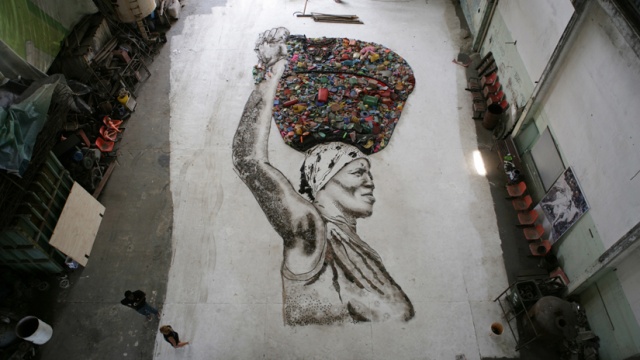|
Reviews of Recent Independent, Foreign, & Documentary Films in Theaters and DVD/Home Video

WASTE LAND Waste Land starts out as another feel-good fawner over a successful guy from the ’hood bestowing benevolence on his hard knocks hometown. But when multi-media artist Vik Muniz creates art out of garbage, everyone involved is startlingly transformed. From his studio in New York, Muniz sculpts junk and unusual materials into recreations of old masters’ portraits that he then photographs with a contemporary interpretation. Trailed by filmmaker Lucy Walker (2002’s Devil’s Playground and 2006’s Blindsight), he returns to his native Brazil to make a piece that will be auctioned off for charity, with a vaguely paternalistic idea of involving slum residents of Rio de Janeiro in the project. His wife (his ex by the end of this three-year effort) sounds cynically realistic when she harangues about the difficulties—logistics, disease, and, most of all, raising financial (and other) expectations of fragile people through their short-term involvement with him. Muniz has an adventurous local partner, Fabio Ghivelder, who had organized their earlier art project with poor kids in a nearby favela. He sees the potential for a genuinely participatory process with a diverse community of spirited workers—young, old, mothers, fathers—who have for years precariously lived in and off of Rio’s huge garbage dump, the largest in the world. These catadores (Portuguese for scavengers) have organized an enterprising co-operative, the Association of Recycling Pickers of Jardim Gramacho, and proudly guide the outsiders through the scrappy lives of their members and the social anthropology of the scrap itself. (Their day-after carnival from the leftovers of the city’s celebration is particularly colorful.) Walker creates indelible documentary portraits of the six workers that round out Muniz’s very unusual physical portraits. By getting to know them intimately, he picks Old Master references with a special resonance for each. Muniz selects The Death of Marat by Jacques-Louis David for Tiaõ, the co-op’s charismatic leader, to reenact in a bathtub plucked from the garbage pile. Tiaõ is certainly revolutionary—he was inspired to organize the co-op from discarded political texts in the garbage, and he spearheads alternatives for the workers for when the dump closes (scheduled for next year). The posed photograph is then re-created in giant Seurat-style pointillism with salvaged materials, seen coming together in a time-lapse sequence. Muniz erects a high scaffold in his warehouse studio to photograph the three-dimensional collage, which will be exhibited and auctioned in London to benefit the co-op. When each of the scavengers-turned-models climb up on that ladder to finally see how the entire project has come together, their reactions are revelatory. Another participant, Zumbi started a lending library with the books he found discarded in the garbage. Irma uses the freshest food discards to cook up al fresco meals. Other girls and women, with life stories of striving to overcome abuse and abandonment, are proud to support their families by recycling materials from the landfill instead of resorting to prostitution. Muniz captures that ethic by posing one like a young Renaissance Madonna, another like Picasso’s Women Ironing, and others like Millet’s The Gleaners, with Walker similarly referencing Agnès Varda’s visual essay The Gleaners and I (2000). (T.S. Eliot’s poem The Waste Land inspired the title.)
Waste Land
was just nominated for the Academy Award for best documentary (and will
soon be shown on PBS’s Independent Lens), adding to recent Oscar-shortlisted
documentaries that have followed people pulling out livelihoods from
refuse,
Guatemalans in
Leslie Iwerks’s Recycled Life (2006) and Egyptians in Mai
Iskander’s Garbage Dreams (2009). Muniz,
Ghivelder,
and Walker do not just passively spotlight the usual
saccharine shock at poverty. They together
honor the workers and recognize their dignity and continue to channel
contributions to the participants’ nascent
entrepreneurial efforts.
Nora Lee Mandel
|

